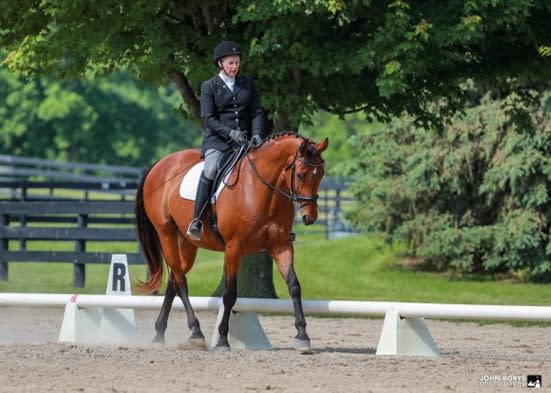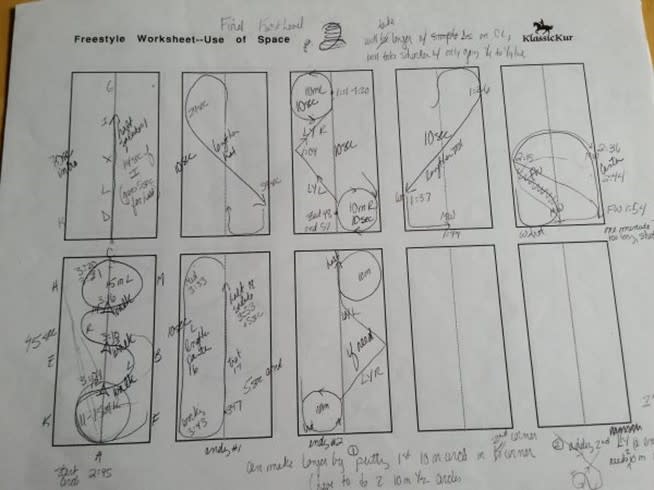Simple Steps to Dressage Musical Freestyle Bronze Medal

My Goal for the 2017 Competition Year is to earn a USDF Bronze Bar for Achievement in Freestyle Dressage! Now that Newman and I have earned our United States Dressage Federation (USDF) Bronze Medal for scores at the First, Second, and Third Levels, it’s time to round out our award shelf with a Bronze Bar for scores at First, Second, and Third Level freestyle! We’ve already collected First and Second-Level Freestyle scores. Now we just need our Third Level Freestyle scores to be complete.
Becoming Eligible for Freestyles
Of course, it’s not quite that simple. First, you have to become eligible to ride freestyle at a level. You do this by earning at least 60% at the highest test of that level. Then, when you enter a freestyle class at a show, you must add that test to the entry as proof that you’re eligible.
Selecting the Right Tempo Music
I plan to use new music for my Third Level freestyle. I used the same piece (Mediterranean guitar, a little piano) for both my First and Second level freestyles, but I’ve found a dramatic movie score that fits my horse’s looks and way of going. I won’t say what it is—that’ll be a surprise!
The next step for me is choreographing the freestyle. Here are the compulsory movements for Third Level:
- Walk (20m minimum continuous medium walk)
- Walk (20m minimum continuous extended walk)
- Shoulder-in at trot (left and right)
- Trot half-pass (left and right)
- Extended trot
- Canter half-pass (left and right)
- Flying change of lead (left and right)
- Extended canter
- Halts at beginning and end of test
Designing Your Choreography

The trick in designing choreography is not being test-like but creatively using the whole arena, especially in the center of the arena, and surprising the judge. It shouldn’t be difficult for the judge to tell what movement you’re doing, and extra points if you combine two movements. At the same time, it’s important to highlight your horse’s strengths and diminish his weaknesses as much as possible. For example, Newman’s flying change from right to left is decent, so I place that one right in front of the judge, but he’s weak in changing from left to right so that one occurs farther away.
What looks good on paper sometimes doesn’t always ride smoothly. So, it’s important to ride the freestyle, and make adjustments. I’m working on this now, and it can be frustrating and fulfilling. On the one hand, you might find a corner or circle develops the bend for lateral movements beautifully and solves one problem, but on the other hand, it creates a new one as maybe you end up facing the wrong direction or going the wrong way. It’s easy to spend a lot of time making adjustments!
Video the Final Choreography Test
Record yourself riding the final choreography in a regulation-sized arena so the music can be set. You’ll need a camera, a friend or tripod, and a sound editor. I spend an evening in front of my TV and computer, watching the freestyle and playing the music repeatedly until the timing matches. While hitting most of the obvious musical phrasing is important, I tend to focus on the entrance and end, so that my first and last impressions are spectacular.
Sometimes I don’t have the time, or the weather doesn’t cooperate and let me ride my new freestyle outside to music, so I have to wing it in the show ring. For your first time riding a freestyle in a competition, I don’t recommend this, as freestyle competition can be very stressful itself, and the last thing you need is uncertainty. In the lower levels, you do not have to submit your choreography to the judge beforehand. If you get ahead or behind your music, you can improvise on the spot, which can also be stressful.
Putting it All Together

In a nutshell, here are the steps I need to take to achieve my 2017 Dressage Competition Goal and the status of each:
- Step 1: Collect First and Second Level Freestyle scores. DONE
- Step 2: Become eligible to ride a Third Level Freestyle test by earning at least 60% at the highest test of the level DONE
- Step 3: Select music DONE
- Step 4: Choreograph freestyle DONE
- Step 5: Ride freestyle and tweak IN PROGRESS
- Step 6: Video final freestyle ride IN PROGRESS
- Step 7: Use a sound editor to set it to music IN PROGRESS
- Step 8: Practice the freestyle to music, hopefully at least once before competing PENDING
- Step 9: Collect Bronze Bar at USDF Convention in December!